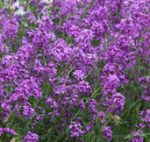 Dames rocket is a biennial or short-lived perennial known by a variety of names including dame’s violet, mother of the evening, and sweet rocket. It was introduced from Eurasia into North America by early European settlers in the 17th century as an ornamental, but escaped cultivation and has become invasive in open woodlands, prairies, roadsides, ditches and other disturbed areas in most of North America to North Carolina, Arkansas, and California. The plants grow from a taproot with coarse secondary roots and produce a rosette of leaves the first year. In the second year plants grow 1-3′ tall and have sparingly branched hairy stems carrying 6′ long lanceolate leaves with dentate margins. From spring to mid summer, white to pink and lavender flowers appear in loose terminal racemes 6-18″ long. Each 4 petaled flower is 3/4-1″ across and very fragrant especially in the evening. In fall, long dry seed pods appear bearing several seeds and a single plant can produce up to 20,000 seeds in a season. Grows in sun to partial shade and average, medium moist, well-drained soil in USDA Hardiness Zones 3-8
Dames rocket is a biennial or short-lived perennial known by a variety of names including dame’s violet, mother of the evening, and sweet rocket. It was introduced from Eurasia into North America by early European settlers in the 17th century as an ornamental, but escaped cultivation and has become invasive in open woodlands, prairies, roadsides, ditches and other disturbed areas in most of North America to North Carolina, Arkansas, and California. The plants grow from a taproot with coarse secondary roots and produce a rosette of leaves the first year. In the second year plants grow 1-3′ tall and have sparingly branched hairy stems carrying 6′ long lanceolate leaves with dentate margins. From spring to mid summer, white to pink and lavender flowers appear in loose terminal racemes 6-18″ long. Each 4 petaled flower is 3/4-1″ across and very fragrant especially in the evening. In fall, long dry seed pods appear bearing several seeds and a single plant can produce up to 20,000 seeds in a season. Grows in sun to partial shade and average, medium moist, well-drained soil in USDA Hardiness Zones 3-8
Fireweed (Chamerion/Epilobium angustifolium)
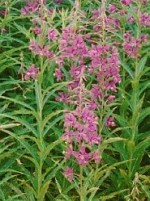 Fireweed is a rhizomatous herbaceous perennial is native to most of North America as well as Eurasia where it is found in disturbed sites such as meadows and roadsides, and is especially common after fire. Growing 2-5′ tall, it has reddish stems bearing long narrow willow-like leaves up to ten inches in length. The stems are topped by a spike of fifty or more pink, magenta or, occasionally white, flowers in summer. USDA Hardiness Zones 3-8
Fireweed is a rhizomatous herbaceous perennial is native to most of North America as well as Eurasia where it is found in disturbed sites such as meadows and roadsides, and is especially common after fire. Growing 2-5′ tall, it has reddish stems bearing long narrow willow-like leaves up to ten inches in length. The stems are topped by a spike of fifty or more pink, magenta or, occasionally white, flowers in summer. USDA Hardiness Zones 3-8
Godetia aka Satin Flower (Clarkia amoena)
 A native of Chile and western North America from San Francisco to British Columbia, this annual thrives in cool weather and does not do well in hot humid conditions. The four petaled cup-shaped flowers resemble those of its cousin, evening primrose, and are borne in the axils of the leaves near the top of the stem. The satiny flowers may be white, pink, or lavender and most have conspicuous splashes of color in the centers that are especially attractive. USDA Hardiness Zones 2-11
A native of Chile and western North America from San Francisco to British Columbia, this annual thrives in cool weather and does not do well in hot humid conditions. The four petaled cup-shaped flowers resemble those of its cousin, evening primrose, and are borne in the axils of the leaves near the top of the stem. The satiny flowers may be white, pink, or lavender and most have conspicuous splashes of color in the centers that are especially attractive. USDA Hardiness Zones 2-11
Sticky Geranium (Geranium viscossissimum)
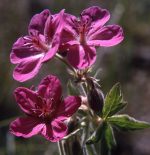 This long-lived herbaceous clump-forming perennial native to the mountains and foothills of northwestern North America from Saskatchewan and British Columbia, south to Nevada and California, where it grows in pine forests, mountain meadows, hillside scrub, grassy plains, and wet land-riparian sites. Plants grow 1-3′ tall from a long taproot and have stout branching stems and bright green leaves. Both stem and leaves are densely covered with sticky hairs. The palmate leaves are mostly basal, long stalked, and deeply divided into 5-7 toothed lobes. From early spring into summer pinkish-lavender to purple flowers with reddish veins appear in loose clusters well above the leaves. Rocky USDA Hardiness Zones 3-9 Photo Credit: RG Johnson, Wikipedia
This long-lived herbaceous clump-forming perennial native to the mountains and foothills of northwestern North America from Saskatchewan and British Columbia, south to Nevada and California, where it grows in pine forests, mountain meadows, hillside scrub, grassy plains, and wet land-riparian sites. Plants grow 1-3′ tall from a long taproot and have stout branching stems and bright green leaves. Both stem and leaves are densely covered with sticky hairs. The palmate leaves are mostly basal, long stalked, and deeply divided into 5-7 toothed lobes. From early spring into summer pinkish-lavender to purple flowers with reddish veins appear in loose clusters well above the leaves. Rocky USDA Hardiness Zones 3-9 Photo Credit: RG Johnson, Wikipedia
Rocky Mountain Beardtongue (Penstemon strictus)
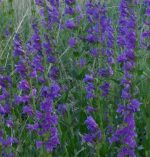 A native of the US from southern Wyoming to Arizona where it is often associated with conifers or sagebrush, Rocky Mountain beard-tongue is an evergreen perennial with rich blue to purple flowers on 1-3’ stems rising above a low mat of foliage in early summer. The leaves are glossy and range from narrow and grass-like to long and broad. Plants spread slowly but can form large clumps. USDA Hardiness Zones 3-8
A native of the US from southern Wyoming to Arizona where it is often associated with conifers or sagebrush, Rocky Mountain beard-tongue is an evergreen perennial with rich blue to purple flowers on 1-3’ stems rising above a low mat of foliage in early summer. The leaves are glossy and range from narrow and grass-like to long and broad. Plants spread slowly but can form large clumps. USDA Hardiness Zones 3-8
Carolina Phlox (Phlox carolina)
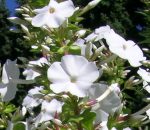 Also known as thick-leaf phlox, this herbaceous perennial is native to southeastern US from North Carolina and Kentucky, south to Florida and Mississippi where it grows in woodland edges and openings. Plants grow 24-30″ tall and have slender stems that are sometimes streaked with red and carry 5-12 pairs of bright green leaves that are oval to lance-shaped and 1.5 to 4″ long. From summer to fall loose cylindrical terminal clusters of white to pink or lavender flowers appear. USDA Hardiness Zones 3-8
Also known as thick-leaf phlox, this herbaceous perennial is native to southeastern US from North Carolina and Kentucky, south to Florida and Mississippi where it grows in woodland edges and openings. Plants grow 24-30″ tall and have slender stems that are sometimes streaked with red and carry 5-12 pairs of bright green leaves that are oval to lance-shaped and 1.5 to 4″ long. From summer to fall loose cylindrical terminal clusters of white to pink or lavender flowers appear. USDA Hardiness Zones 3-8
Smooth Phlox (Phlox glaberrima)
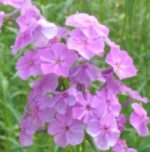 This herbaceous perennial, also called marsh phlox, is native to midwesternand southeastern US from Maryland to Wisconsin, south to Florida and Texas where it grows in moist to wet areas of prairies, meadows, and woodlands. Plants grow up to 4′ tall from a taproot and have unbranched, slender, hairless stems bearing medium to dark green opposite lanceolate leaves. From late spring to early summer, terminal dome-shaped clusters up to 12″ long appear bearing 3- 20 pink to lavender, fragrant flowers that are attractive to hummingbirds and butterflies. USDA Hardiness Zones 3-8
This herbaceous perennial, also called marsh phlox, is native to midwesternand southeastern US from Maryland to Wisconsin, south to Florida and Texas where it grows in moist to wet areas of prairies, meadows, and woodlands. Plants grow up to 4′ tall from a taproot and have unbranched, slender, hairless stems bearing medium to dark green opposite lanceolate leaves. From late spring to early summer, terminal dome-shaped clusters up to 12″ long appear bearing 3- 20 pink to lavender, fragrant flowers that are attractive to hummingbirds and butterflies. USDA Hardiness Zones 3-8
Purple Dragon Head (Physostegia parviflora)
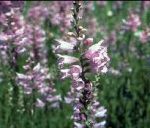 This herbaceous perennial is also called western false dragon head is native to Manitoba to British Columbia, south to Illinois, Utah, and Oregon where it grows in marshes, streams and lake margins in lowlands and montane zones. Plants have a rhizomatous root system and simple or branched 4-angled stems 8-40″ tall. The sessile leaves are linear and up to 4′ long with pointed tips and finely toothed margins. In summer, terminal and axillary spikes 3/4″-3″ long of white, pink or lavender flowers appear.
This herbaceous perennial is also called western false dragon head is native to Manitoba to British Columbia, south to Illinois, Utah, and Oregon where it grows in marshes, streams and lake margins in lowlands and montane zones. Plants have a rhizomatous root system and simple or branched 4-angled stems 8-40″ tall. The sessile leaves are linear and up to 4′ long with pointed tips and finely toothed margins. In summer, terminal and axillary spikes 3/4″-3″ long of white, pink or lavender flowers appear.
Garden Phlox (Phlox paniculata)
 Garden phlox is a clump-forming herbaceous perennial native to eastern US from Main west to Minnesota, south to Georgia and Louisianna where it grows in woodland clearings and borders, meadows, lightly shaded riparian areas, thickets, and moist roadsides. Plants grow up to 4′ tall from a taproot and have smooth unbranched stems, sometimes with purple streaks, and bearing narrow dark green pointed leaves 4-7″ long. From mid summer to fall, terminal pyramidal panicles of fragrant flowers appear that are 4-8″ across. USDA Hardiness Zones 4-8
Garden phlox is a clump-forming herbaceous perennial native to eastern US from Main west to Minnesota, south to Georgia and Louisianna where it grows in woodland clearings and borders, meadows, lightly shaded riparian areas, thickets, and moist roadsides. Plants grow up to 4′ tall from a taproot and have smooth unbranched stems, sometimes with purple streaks, and bearing narrow dark green pointed leaves 4-7″ long. From mid summer to fall, terminal pyramidal panicles of fragrant flowers appear that are 4-8″ across. USDA Hardiness Zones 4-8
Checkerbloom (Sidalcea malviflora)
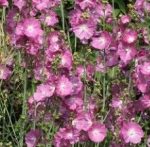 Checkerbloom is a herbaceous perennial native to western North America from Alberta and British Columbia south to Nevada, Colorado, and Oregon where it grows in prairies, subalpine meadows, chaparral , coastal sage scrub, roadsides and similar habitats. The basal leaves are rounded, lobed and up to three inches across while the stem leaves are palmately lobed with five to seven smooth segments. The lilac to pink or rose flowers are 1-5″ across have five petals, and are carried in loose terminal racemes on stout stems during the summer. USDA Hardiness Zones 5-7
Checkerbloom is a herbaceous perennial native to western North America from Alberta and British Columbia south to Nevada, Colorado, and Oregon where it grows in prairies, subalpine meadows, chaparral , coastal sage scrub, roadsides and similar habitats. The basal leaves are rounded, lobed and up to three inches across while the stem leaves are palmately lobed with five to seven smooth segments. The lilac to pink or rose flowers are 1-5″ across have five petals, and are carried in loose terminal racemes on stout stems during the summer. USDA Hardiness Zones 5-7